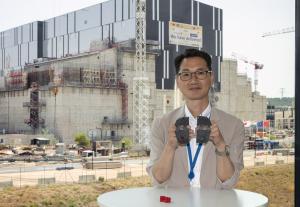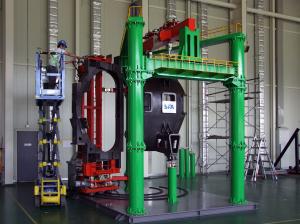A daunting task for a young engineer
A conceptual document, however, is not a "nuts and bolts" blueprint. "It's more of a concept for how the tool is supposed to operate," explains Robert Shaw, presently in charge of coordinating ITER machine assembly and at the time closely associated with SSAT conceptual development. "A conceptual document shows the geometry, the kinematics (the geometry of motion), the specifics for the weight to be supported and the precision to be obtained. But conceptual designs require quite a bit of fleshing out before you have an actual design document." And that is precisely the job that was passed on by ITER Korea to SFA Engineering in 2006.
"No one had ever manufactured a tool like this, capable of handling and assembling with millimetric precision components that are up to 17 metres tall and weigh in excess of 400 tonnes," says Kyoung Kyu Kim. "The kinematics were extraordinarily subtle and complex. In order to position the vacuum vessel sector and the toroidal field coils, the moving parts of the tool needed to handle six degrees of freedom: up and down, side to side, forward and backward, plus rotational directions (swivel, tilt, pivot) relative to the axes..."
No tool this size, not even in the shipbuilding world, and with such complexity had ever been manufactured. The challenge was both structural and functional and Kyoung Kyu Kim, ITER Korea, and SFA agreed that it was safer to build and test a model, one-fifth of the tool's actual size. By 2010, the mockup was ready and operational, and it demonstrated kinematics "with no real feasibility issue."
The rest of the story has been chronicled in the ITER Newsline—from the progress of manufacturing at Taekyung Heavy Industries in the port city of Changwon, to the arrival of the first SSAT elements on the ITER site and the subsequent assembly of the two identical twins beginning in late 2017.
Five years later, the SSATs have succeeded in the first steps of their immense task: a first "module" was assembled in 2021-2022 and installed in the Tokamak pit last May; a second one has recently entered the same process and should be ready by the end of the year. Seven others will follow the same path in order to complete the machine torus.
For Kyoung Kyu Kim, designing the ITER sector sub-assembly tools was a defining experience and a lesson in determination that oriented his subsequent career. Through the company he later founded and heads—Mecha T&S Inc. (Mechanical Total Engineering Solution)—the 31-year old engineer of 2006 now works for Korea's nascent space industry, another way to contribute to the future of humankind.



